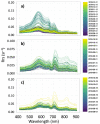Detecting Climate Driven Changes in Chlorophyll-a Using High Frequency Monitoring: The Impact of the 2019 European Heatwave in Three Contrasting Aquatic Systems
- PMID: 34577449
- PMCID: PMC8473262
- DOI: 10.3390/s21186242
Detecting Climate Driven Changes in Chlorophyll-a Using High Frequency Monitoring: The Impact of the 2019 European Heatwave in Three Contrasting Aquatic Systems
Abstract
The frequency of heatwave events in Europe is increasing as a result of climate change. This can have implications for the water quality and ecological functioning of aquatic systems. We deployed three spectroradiometer WISPstations at three sites in Europe (Italy, Estonia, and Lithuania/Russia) to measure chlorophyll-a at high frequency. A heatwave in July 2019 occurred with record daily maximum temperatures over 40 °C in parts of Europe. The effects of the resulting storm that ended the heatwave were more discernable than the heatwave itself. Following the storm, chlorophyll-a concentrations increased markedly in two of the lakes and remained high for the duration of the summer while at one site concentrations increased linearly. Heatwaves and subsequent storms appeared to play an important role in structuring the phenology of the primary producers, with wider implications for lake functioning. Chlorophyll-a peaked in early September, after which a wind event dissipated concentrations until calmer conditions returned. Synoptic coordinated high frequency monitoring needs to be advanced in Europe as part of water management policy and to improve knowledge on the implications of climate change. Lakes, as dynamic ecosystems with fast moving species-succession, provide a prism to observe the scale of future change.
Keywords: Cyanobacteria blooms; WISPstation; chlorophyll-a; climate change; high-frequency monitoring; lagoon; lake; phytoplankton.
Conflict of interest statement
The authors declare no conflict of interest.
Figures









References
-
- Likens G.E. Encyclopedia of Inland Waters. Academic Press; Cambridge, MA, USA: 2010. Lake ecosystem ecology: A global perspective.
-
- Lewis W.M. Encyclopedia of Inland Waters. Academic Press; Cambridge, MA, USA: 2014. Lakes as Ecosystems.
MeSH terms
Substances
LinkOut - more resources
Full Text Sources

